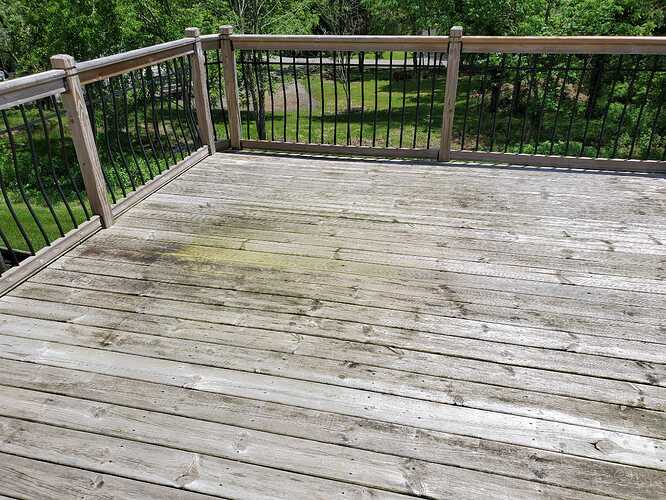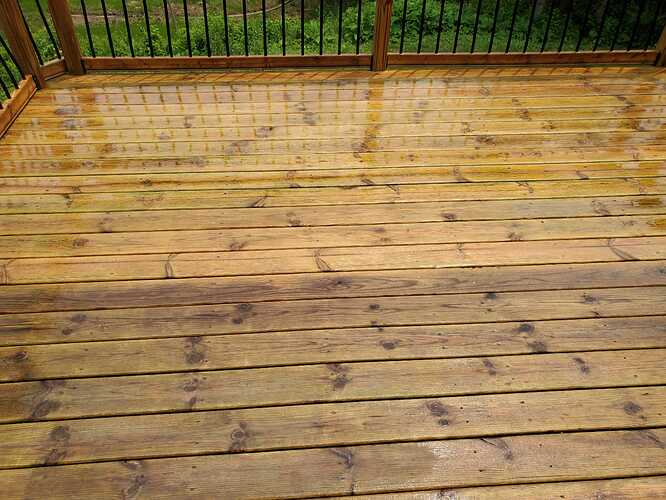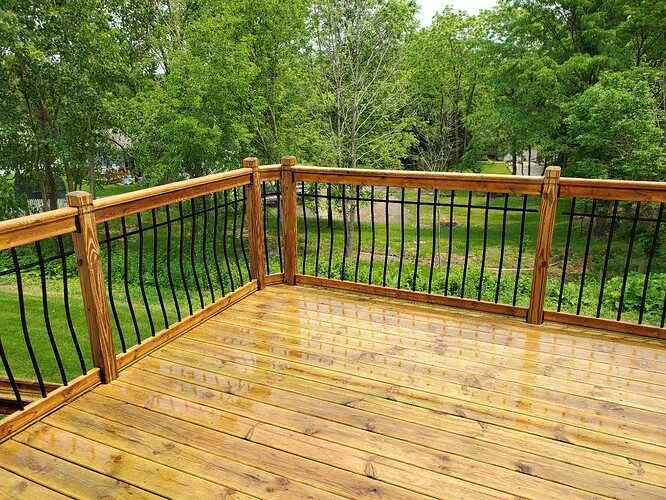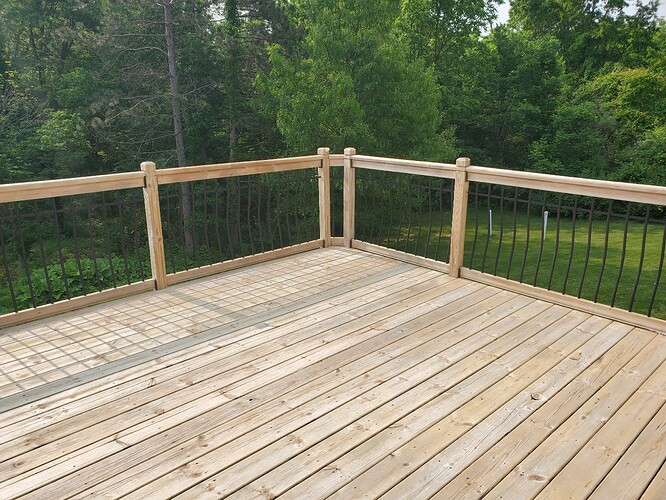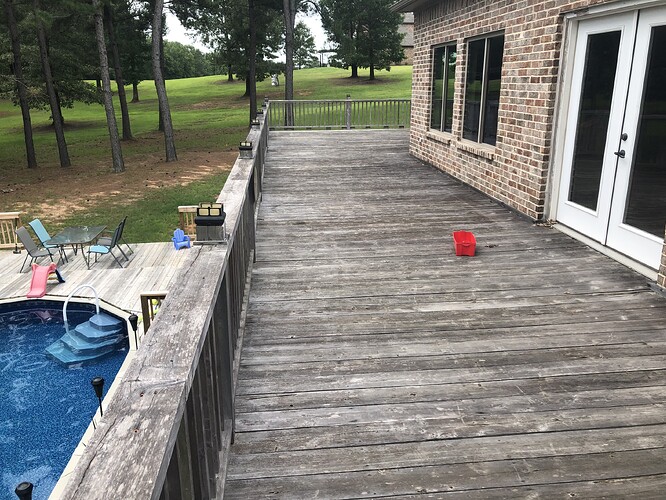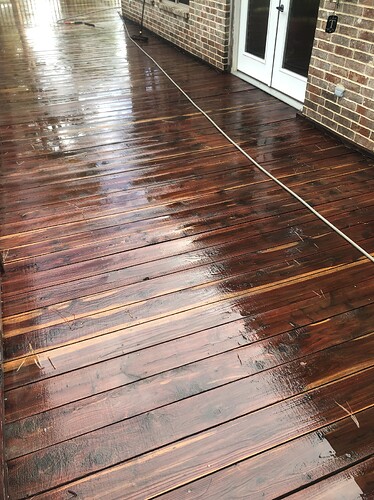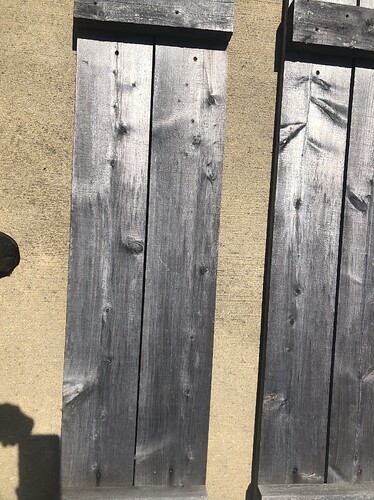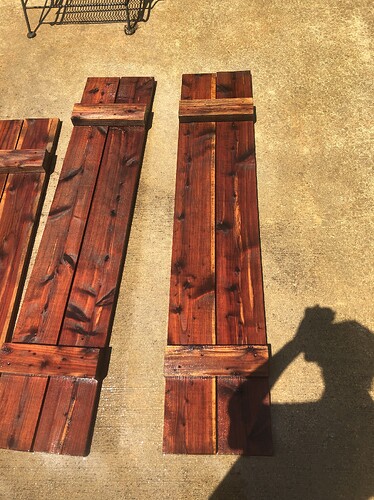Yeah me to. Went on a rant about truck chemicals, sorry @Racer. Keep it wood restoration and cleaning for the new fellas and alike
Heck, even @Grizz stayed on topic, so we know it’s possible for anyone, lol.
Yes sir. My apologies.
@Racer I took Everett Abram’s 2 day wood restoration class last year. I remember him saying that citric is no good at neutralizing and to always use oxalic. I do not know for certain as I have never used citric. Do you have any thoughts on his statement?
I’ve taken some of his courses too, but have never heard him say that. There are some other guys that do a lot of wood that only use Citric. The only advantage of Ox is that it will help remove nail stain bleed better. Look at them both on PH scale. Very minor difference. Ox is a little more acidic like 1.3 - citric is 2.2
Makes sense. Thank you
Here’s one a did a few months back. It was in another thread awhile back so might look familiar to some. It was a second story deck about 10’-12’ off the ground. It has never been stained but not sure of age. The new owners have been there 4 years so know it’s at least that old.
I used sodium percarbonate mixed at 10oz/gallon. Sodium Percarbonate is more mild than SH and is less likely to cause furring. I don’t think it cleans quite as well as SH unless you give it a quick scrub with a deck brush. If you do that you can’t tell a difference. You definitely don’t have to sand as much before staining when using percarbonate. I decided to use percarb on this deck because there wasn’t a ton of algae growth. There weren’t any spindles to worry about so scrubbing wasn’t an issue. Plus, there was already some furring just from the wood being so weathered and I wanted to minimize anymore then necessary since it was going to be stained.
When using percarbonate I spray enough to where it almost puddles in areas, let sit for 10 minutes or so, hit the deck boards with a deck brush, and then apply a light second round. I lightly mist water thereafter to keep wet. After a dwell time of 10-15 minutes I rinse using around 1000 psi. I always apply oxalic to brighten/neutralize and at 8oz/gallon. It works pretty fast but I let dwell for about 10 minutes while lightly misting to keep from drying. The deck then gets a good rinse.
This next picture was taken right after it was cleaned and during brightening/neutralizing. I wanted a picture that showed how much of a difference wood brightening makes. Obviously oxalic has been applied to the top section and not yet to the bottom.
Here’s after brightening/neutralizing.
This is the next day after it dried.
Just for the general knowledge, can you give us a rough estimate on the price difference between sodium percarbonate and SH? More or less expensive? It sounds like it may require a bit more chemical to fully clean but it definitely looks amazing.
I think the only positive of it over sh is less risk of furring. It’s more mild so a good choice in some circumstances like type of wood or if it looks like a deck where furring may be an issue. I’ve noticed it more with decks that are in the shade more and don’t dry out very often. Could maybe also be a good choice if nails were used. I’m just thinking more along the lines of corrosion that sh causes. Although, it shouldn’t be an issue if you rinse well. It’s also a great choice if you’re worried about a lot of expensive landscaping because it won’t hurt it. Well, at least for me since SH is about $3 a gallon.
As far as price it’s about $3 per pound. You can get buy mixing at 8oz/gallon so you’re looking at $1.50 per gallon. It might take a little more compared to sh just because it doesn’t clean quite as well but depends on how dirty the deck is. It’s close enough in price to where it’s not worth worrying about.
Great post as always @Racer. Keep up the great work and info Rick!
Good info from everyone else also. Great thread everyone.
@Racer, define just a pinch of sodium hydroxide if you do not mind.
I have been using just bleach and soap and neutralizing with oxalic.
Have not tried downstreaming sodium hydroxide. Thanks Rick!
Excellent post Brian.
Just about 1/2 cup per gal in with the SH. Kind of like turbo charging, lol. Gives the SH just a little kick. Probably wasn’t necessary but always experimenting.
Great lesson from THE @Racer!! I’ve had 2 experiences with Cedar ( same property) and this is how I found works best for me. 1.25 cups of tsp per gallon of water with a touch of SH less than 1%. Wet surface, apply mix with backpack sprayer, I like to walk and pump ![]() , let dwell. Rinse, rinse, and apply oxalic with sprayer then rinse again. I don’t know whether or not it’s all cedar or just this particular case but it did not clean as well with 1% SH/Elemonater or Percarb. But on pressure treated percarbonate has been great. Never tried citric acid before but might have to try it now
, let dwell. Rinse, rinse, and apply oxalic with sprayer then rinse again. I don’t know whether or not it’s all cedar or just this particular case but it did not clean as well with 1% SH/Elemonater or Percarb. But on pressure treated percarbonate has been great. Never tried citric acid before but might have to try it now
Looks good. Great job on those columns and shutters. I wish we had some cedar decks around here. They’re all PT pine or if they upgrade they go to Trex. Thanks for the post.
Thanks for the post using sodium percarbonate, what sqft does your gallon generally cover? I have found I’m covering about 400sqft/G.
Thanks
@Racer Once again another great helpful thread. Thank you so much for giving your knowledge.
Great post Rick @Racer. I am about to start a PT deck that has mostly failed Thompson’s Water Seal on it. I hate that stuff and up charged accordingly. I have zero luck posting pics lately so I’ll see what I can do as the job unwinds. I’ll do a separate post to add a few things I have found doing wood since we do 90% cedar but we don’t have many decks in relative terms. You can delete this as needed.
I’ve been waiting for you to chime in here. You’ve done a ton. Cedar is fine. Post away to this thread. What I’m trying do is have one major thread we can refer people who come here with wood questions.
Different types of wood get different treatment based on what the desired end result is. I don’t just clean decks or fences, there’s no demand for it here. If you are doing it in DFW you will be staining it too.
General Comment: RIck’s methodology 1. Pre-wet 2. Apply Chems 3. Rinse 4. Ox/citric rinse 5. Rinse is the only right way to do wood with some minor adjustments based again on what the desired end state is. Oil based transparent, semi-transparent or water based solid. If I am using a water based product it will be a solid, anything else is oil.
Grill Grease: I have had good luck getting rid of or minimizing grill grease on decks using potassium hydroxide in conjunction with scrubbing using a short bristled stiff Quikie Brush (about $8.00 with handle ay HD or Lowe’s). It is the same brush I use for most scrubbing. For really deep stuff I have been known to break out a wire brush. Wire brushes are also handy for smoothing out wand marks. I know none of you have ever done it but I might have. Side note wire brushing works on fences too. You can upcharge a bunch fixing what someone else did with a pressure washer. Then stain it.
Cedar Decks: I almost always use sodium percarbonate verses SH. Cedar is much more prone to furring and errant wand marks than PT SYP. So it tracks more with what @marinegrunt described. I do use SH if it has particularly stubborn algae but even then sparringly.
Pressure Treated using either @Racer or @marinegrunt steps gets the job done. Boards oozing pine sap need to be replaced, period. Even if you sand them down or use a Diamabrush the sap will come back. Keep in mind my reference is for staining after cleaning so sap is a non-starter for me.
Ox/Citric: I use Ox. I buy it in 50lb boxes from powerwash.com. I don’t remember what I paid for it but it works and they are local (they will also give you a small discount if you are a Vet but you have to talk to them on the phone to get it). I was in a half day class with Everett Abrams a few weeks ago. He did not say no to citric but he did say what has been said here that for nail bleeds Ox is the way to go. If you haven’t kept up he has a complete deck restoration system of chemicals and system to support it. He has also introduced a water based stain that will allow you to apply it when the wood is still wet, which makes a deck cleaning and staining a one day job. I have not tried it but I did see him demo it. I will try it when the right opportunity presents itself. Sorry for the informercial but he’s doing some good stuff.
Stripping Decks: First question is what’s on there now? Water based, oil based etc. Second is what is the desired end state?
- Not sure what’s on there now? Badly failed water based can absorb water and fool you into thinking it is oil but is won’t take stain the same way. Use denatured alcohol and rub firmly. Water based will come off and show color oil based will not.
- Re-stain using the same type of product or do they want or need to switch? I have used sodium and or potassium hydroxide. I usually start at 8oz per gal and adjust up or down as needed to allow minimal pressure but still get the coating off. Back to Everett’s stuff, if you are not sure what or how to use it, he has a stripper out now that has sodium hyd, metasillicate and Butyl already mixed. I have used it on a Thompson’s treated deck and a water based Cedar garage door both with excellent results. If you are not comfortable or lazy like I am it’s worth looking into.
Mechanical Stripping/Refinishing: I have not and don’t intend to get into floor sanders. I don’t do enough to justify the learning curve or expense. I have used with good success the Diamabrush for stuff that just won’t strip without really tearing up the wood. I did not use the dust attachment but I would going forward because it makes a lot of dust. Practice on scrap wood first, there is a learning curve and less is more. Sanding railings etc. I use an orbital sander with 80 grit or coarser, again relates to stain since fine finish sanding prevents proper absorption.
What to charge: I am probably on the high side but I charge 4-5.00 per square foot for the deck and 4.00 per linear foot for spindles. I make exceptions if they have a large fence or I am doing pressure washing for them but straight up for decks this is the price. I am the same way with pergola’s and we have tons of them. I don’t like doing them but they pay pretty well.
Hope this helps.
